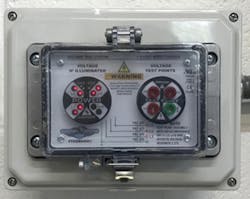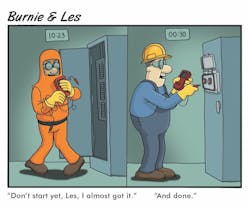A city in Virginia has 411 waste water lift stations. During a partial power outage 200 stations were left without power. Each station requires a visit to determine if the power company needs to be called or if the station can be reset. Since testing was required to determine presence or absence of voltage, two persons were required to meet at the station; one lift station technician and one electrician. A restart of the lift station was required if utility power was available. After the power outage it was necessary to confirm incoming voltage.
The problem is this normally requires removing the front panel of a switchgear or opening the motor control cabinet and testing for utility power with both a technician and an electrician present. Grace’s representatives teamed with local distributors for a solution and suggested using the Grace PESD® Voltage Test Station (VTS); our combination unit of the Safe-Test Point® Voltage Portal & R-3W Voltage Indicator mounted within a protective housing. They also put forward the idea of shipping the unit installed on its own enclosure. This allowed the wastewater facility to install the VTS without modifying the switchgear or motor control centers. With the help of our representatives, Grace was able to create a new product application.
The Solution
Mounting the VTS onto its own enclosure allowed for installation without modifying the face or side of the switchgear or motor control center. The assembled unit could be mounted beside the switchgear or motor control center on the wall or with conduit nipples. This allowed for a quick installation and verification that the unit was working well. Second, the testing and reset of a station could be accomplished by a single lift station technician in much less time then was normally required for two persons, electrician and technician, to coordinate arrival and verify utility power and reset the station.
Since the hazard of exposure to voltage had been mitigated a technician could be trained to verify utility power then do electrical Lockout/Tagout (LOTO) then reset the lift station. A VTS mounted on a suitable enclosure provides testing for LOTO with only one person and takes less than 5 minutes where previously two persons had to coordinate a visit to each lift station and perform LOTO testing as well as reset the station.
This was usually a 45 minute to 1 hour time frame reduced to a mere 5 minutes. Cost savings were realized very quickly on man hours saved. More importantly, when using the VTS, the danger of exposure to energy was mitigated. Safer access and cost savings is driving installation of the VTS on all 411 lift stations in the Virginia city.
In many applications of the VTS the voltage indicator and Safe-Test Point® are both connected to load side. In this application the utility power needed to be verified, so the Voltage Indicator was wired to the line side, while the SafeTest Point® was wired to the load side.
This allowed any operator to verify that utility power was present or absent without testing. While the VTS is typically installed onto the panel doors of switch-gears and motor control centers; the pre-installed version on its own enclosure helped solve several problems. First, installation and verification of the units operation is simplified. Second, time saved performing LOTO far and away exceeds a fully suited, open door operation. Lastly, exposure to electrical energy is mitigated, creating an electrically safe work environment for the technician.
Editor's Note: Scranton Gillette Communications and the SGC Water Group are not liable for the accuracy, efficacy and validity of the claims made in this piece. The views expressed in this content do not reflect the position of the editorial teams of Water & Wastes Digest, Water Quality Products and Storm Water Solutions.

